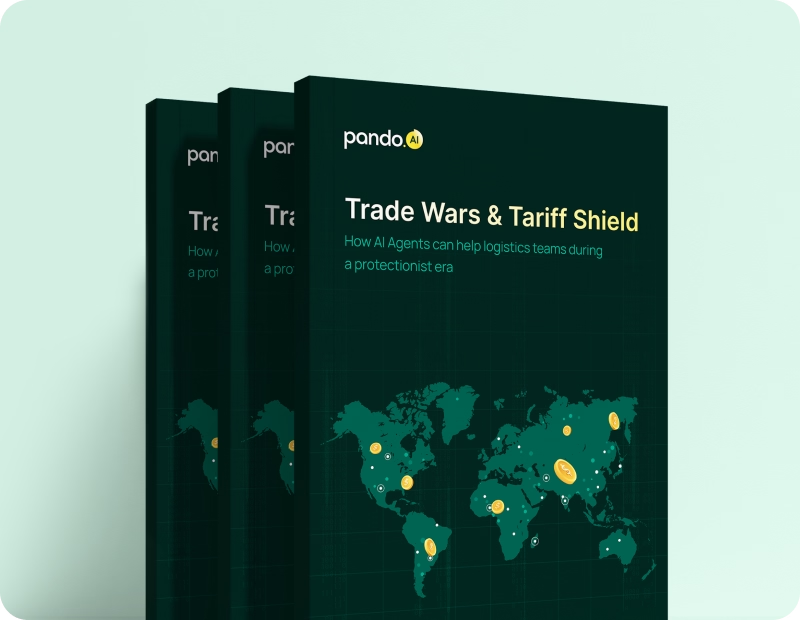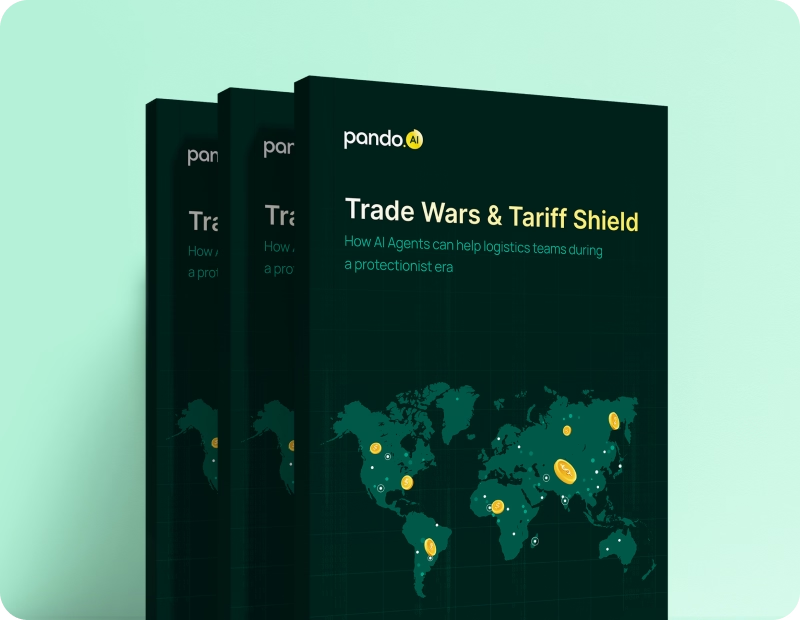-
Products Products
- Industry
- Initiatives
- Resources
- Company
- Book a demo

Before you go: Logistics leaders just dropped the truth on AI
The State of AI in Logistics 2025 is here — no hype, just real conversations and raw insights.
The 90-Day Window: Why AI Agents Are Essential for Navigating Trade Policy Volatility
Transform trade volatility by leveraging AI agents to convert tariff challenges into competitive advantages.
Published on April 11, 2025 • 7 mins read
Sridhar C S

Transform trade volatility by leveraging AI agents to convert tariff challenges into competitive advantages.
The global trade landscape continues to evolve at breakneck speed. While the sweeping "Liberation Day" tariffs initially targeted goods from nearly all trading partners, recent developments have added new layers of complexity. President Trump has paused tariffs for 75 countries for 90 days, while dramatically escalating duties on Chinese imports to an unprecedented 125% following China's retaliatory 84% tariff on U.S. goods. Meanwhile, the baseline 10% tariff remains in effect, as do the 25% duties on automobiles, auto parts, steel, and aluminum imports.
For logistics professionals, this rapidly shifting environment creates extraordinary challenges. The stop-and-go pattern of tariff implementation, combined with varying rates for different countries and product categories, makes traditional approaches to logistics management increasingly ineffective.
Moving beyond reactive approaches to tariffs
As we explored in our previous blog, focusing solely on tariffs rather than comprehensive logistics optimization is a short-sighted strategy. Business leaders have little control over how and when countries enact tariff policies, and reacting to each change creates an endless cycle of short-term management rather than building long-term resilience.
Investing in supply chain optimization and in people, processes, infrastructure, and technology has to be the way forward. Modern technology tools like AI need to be leveraged to build a closed-loop continuous improvement Supply Chain Model. This approach requires sophisticated total landed cost analysis that considers all variables affecting the supply chain, not just tariffs
This wisdom highlights the need for a more strategic approach to managing trade volatility—one that anticipates and adapts to changing conditions rather than merely reacting to them.
Why AI agents are essential in today's trade environment
The current tariff landscape—with its complex mix of paused, baseline, and escalated duties—demands capabilities that exceed traditional logistics management approaches. In times of such unprecedented trade policy volatility, AI agents provide critical advantages that help organizations maintain competitiveness while navigating uncertainty. These intelligent systems can create tariff-resilient supply chains that adapt to policy changes while maintaining operational efficiency. These capabilities are particularly valuable during the 90-day pause, which offers a window to implement intelligent solutions before the next potential policy shift.
Reducing safety stock & freeing up working capital
The escalating tariff situation, particularly the dramatic increase in duties on Chinese imports, has led many manufacturers to frontload inventory as a hedge against cost spikes. While this approach may provide short-term protection, it ties up millions in working capital that could be better deployed elsewhere.
AI agents address this challenge by optimizing freight networks and improving transit consistency. By utilizing sophisticated network modeling and AI-powered network and freight modeling capabilities, these systems analyze historical performance data across carriers and lanes, identify the most reliable transportation options, and complement this with predictive freight tracking/visibility and alerts.
Real-world impact: For auto component manufacturers facing erratic lead times, AI agents' logistics network modeling capabilities can identify carriers and routes with consistent performance records. This intelligence allows companies to reduce safety stock, freeing working capital that can offset some of the tariff impact.
Compliance management and penalty avoidance
With the Buy American Act (BAA) requiring at least 65% U.S. content for government procurement (increasing to 75% by 2029), suppliers face heightened compliance pressures alongside the tariff challenges. This has accelerated the trend toward re-shoring/near-shoring as companies reconfigure their supply networks. Additionally, missing retailer delivery deadlines compounds these issues, resulting in heavy chargebacks and penalties when OTIF (On-Time, In-Full) deliveries aren't achieved.
AI agents' advanced analytical capabilities help organizations avoid these costly penalties through trade compliance automation that monitors shipments in real time, anticipates potential delays, and recommends proactive interventions. The system automatically tracks compliance requirements for both government regulations and retailer specifications, including complex areas like Section 321/Type 86 compliance for e-commerce imports, ensuring shipments meet all necessary standards.
Real-world impact: AI agents can help global consumer goods companies adapt to domestic sourcing rules, reduce procurement costs, and minimize excess inventory through accurate landed cost management and predictive freight tracking, potentially reducing chargebacks significantly.
AI-powered mode selection for optimal cost-speed balance
Many companies overspend on premium freight when lower-cost multi-modal options could maintain service and stock levels at a fraction of the cost. With tariffs increasing the baseline cost of goods, optimizing transportation spending becomes even more critical.
The adaptive freight engine within AI agents dynamically selects the optimal mix of transit modes based on current inventory levels, shipment urgency, carrier performance, and real-time cost fluctuations. This intelligence helps businesses make smarter decisions about when to use expedited services versus standard shipping options. Companies can also leverage green transportation incentives provided under the Inflation Reduction Act (IRA) benefits to further reduce costs while improving Scope 3 emissions reporting for sustainability goals.
Real-world impact: AI agents can identify opportunities to optimize transportation costs through mode selection, potentially offsetting some of the dramatic duty increases. For example, consumer electronics companies who are willing to leverage AI agents will get tactical inputs like shifting non-priority components from air freight to combined sea-air services while maintaining pure air freight for critical parts, balancing between freight costs and delivery SLAs.
Multi-country sourcing optimization to minimize tariff impact
The 90-day pause for 75 countries creates a strategic window for businesses to reconfigure their sourcing strategies. However, making the right decisions requires comprehensive analysis that goes beyond simple tariff comparisons.
AI agents enable businesses to simulate multiple sourcing options from a logistics PoV and choose the most cost-effective network configurations by utilizing an inbuilt total cost analysis model that considers all factors—including tariffs, freight expenses, transit reliability, and customs implications. This capability helps identify potential tariff exemptions and refund opportunities and is particularly valuable for companies looking to shift production away from China amidst tariff tensions.
Real-world impact: Electronics component producers must use AI agents to evaluate alternatives in Mexico, Vietnam, and domestic U.S. production. For example, while intuition might suggest that USMCA-compliant Mexican sourcing is optimal due to duty-free treatment, AI agents can do the math and suggest whether continuing with Vietnam can be a cost-optimized option despite tariffs based on freight costs, customs duties, and other variables. These nuanced decisions impact the bottom line of the organization, something that an AI agent can actively help make.
Exploiting pre-tariff windows for immediate savings
When tariff changes keep on changing daily, companies look to achieve immediate cost relief by expediting shipments through pre-tariff arrival windows before implementation deadlines. AI agents enable businesses to optimize this opportunity by dynamically adjusting transport modes, ensuring cost-effective exploitation of pre-tariff windows.
Real-world impact: For beverage manufacturers facing the 10% baseline tariff increase on imported aluminum, AI agents help fast-track essential shipments before the deadline, saving millions in projected duties. Such opportunities arise whenever tariff changes are announced, and AI agents help decide on mode and network adjustments based on the potential savings.
Turning AI potential into logistics reality with Pi
While the benefits of AI-powered logistics are clear, the specific implementation and technology architecture significantly impact results. Pi is a cognitive system trained on millions of freight movements across global supply chains and enhanced with specialized expertise in tariff compliance, documentation requirements, and transportation economics. Unlike conventional systems that simply execute pre-programmed workflows, Pi continuously learns from emerging patterns and proactively identifies optimization opportunities before disruptions occur.
-
Freight Procurement Intelligence: Pi's multi-scenario tariff modeling simulates thousands of sourcing options, calculating exact costs across different origin-destination pairs and transportation modes to optimize procurement decisions as tariff-driven landed costs shift.
-
Transportation Execution Management: Pi automatically generates customs documentation tailored to specific country requirements, including accurate Harmonized Tariff Schedule (HTS) classification while continuously recalculating optimal routing based on current port congestion, customs processing times, and tariff impacts.
-
Freight Audit and Payment Control: Pi's tariff-aware invoice validation prevents overpayment by verifying charges at the line-item level, while also identifying duty refund opportunities through Post Summary Corrections (PSC) and drawback claims.
-
Freight Insights and Analytics: When trade policies shift, Pi enables sophisticated what-if modeling that incorporates economic forecasts and geopolitical risk assessments to evaluate potential impacts across multiple scenarios.
An important advancement in Pi's capabilities is its integration with GTM (Global Trade Management), which creates a seamless connection between Pi’s transportation management capabilities and trade compliance functions, enabling real-time decision-making that accounts for both logistics efficiency and regulatory requirements.
As supply chains reconfigure to adapt to the multi-layered tariff structure, they inevitably become longer, more complex, and more vulnerable to disruption. Pi's advanced capabilities help transform post-Liberation Day challenges into strategic opportunities for forward-thinking organizations.
Building future-ready supply chains: The path forward
The recent tariff developments—from the initial "Liberation Day" announcement to the 125% escalation for China—highlight a fundamental truth about modern supply chains: volatility is the new normal. Whether through tariffs, geopolitical events, or other disruptions, logistics operations face ongoing challenges that demand agility and resilience.
The 90-day tariff pause provides a critical opportunity to implement AI-driven logistics optimization that will deliver value regardless of future trade policy developments. Leading AI agents like Pi enable organizations to build future-ready supply chains by streamlining the entire logistics lifecycle. From initial freight procurement with dynamic carrier selection through transportation execution with real-time tracking and exception management to automated freight audit and payment—these systems provide continuous optimization across every touchpoint. This comprehensive approach creates an interconnected logistics intelligence network that adapts to changing conditions while maintaining compliance and cost efficiency.
While no one can predict with certainty what trade policies will emerge at the end of the 90-day pause, one thing is clear: organizations that use this time to implement AI-driven logistics optimization—spanning procurement, execution, tracking, and financial settlement—will be better positioned to navigate whatever comes next, turning trade policy volatility from a threat into a potential competitive advantage.
Subscribe to Pando blog and Crossroads newsletter now!
Stay up to date with the latest logistics, transportation, and supply chain tips and news.
Subscribe Here!













